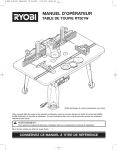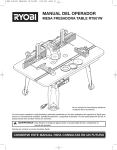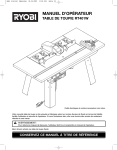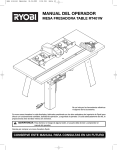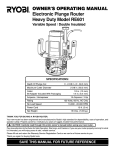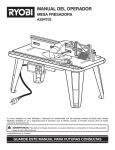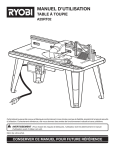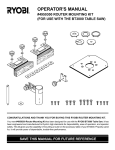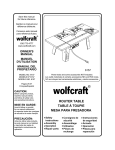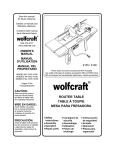Download Ryobi RT501W Specifications
Transcript
This unit was not made by RYOBI. Contact Wolfcraft® @ 888-574-5757, ext. 250 for repair parts. www.wolfcraft.com TABLE OF CONTENTS I I I I I I I I I I I I Introduction . . . . . . . . . . . . . . . . . . . . . . . . . . . . . . . . . . . . . . . . . . . . . . . . . . . . . . . . . . . . . . . . . . . . . . . . . . . . . . .2 Rules for Safe Operation . . . . . . . . . . . . . . . . . . . . . . . . . . . . . . . . . . . . . . . . . . . . . . . . . . . . . . . . . . . . . . . . . . .3-4 Unpacking and checking contents . . . . . . . . . . . . . . . . . . . . . . . . . . . . . . . . . . . . . . . . . . . . . . . . . . . . . . . . . . . . . .4 Features and Specifications . . . . . . . . . . . . . . . . . . . . . . . . . . . . . . . . . . . . . . . . . . . . . . . . . . . . . . . . . . . . . . . . . .5 Package contents and hardware legend . . . . . . . . . . . . . . . . . . . . . . . . . . . . . . . . . . . . . . . . . . . . . . . . . . . . . . . .6-9 Assembly . . . . . . . . . . . . . . . . . . . . . . . . . . . . . . . . . . . . . . . . . . . . . . . . . . . . . . . . . . . . . . . . . . . . . . . . . . . . .10-13 Mounting the router . . . . . . . . . . . . . . . . . . . . . . . . . . . . . . . . . . . . . . . . . . . . . . . . . . . . . . . . . . . . . . . . . . . . .14-17 Switch box . . . . . . . . . . . . . . . . . . . . . . . . . . . . . . . . . . . . . . . . . . . . . . . . . . . . . . . . . . . . . . . . . . . . . . . . . . . .18-20 Operation . . . . . . . . . . . . . . . . . . . . . . . . . . . . . . . . . . . . . . . . . . . . . . . . . . . . . . . . . . . . . . . . . . . . . . . . . . . . .20-23 Accessories . . . . . . . . . . . . . . . . . . . . . . . . . . . . . . . . . . . . . . . . . . . . . . . . . . . . . . . . . . . . . . . . . . . . . . . . . . . . .24 Securing the router table . . . . . . . . . . . . . . . . . . . . . . . . . . . . . . . . . . . . . . . . . . . . . . . . . . . . . . . . . . . . . . . . . . . .24 Repair parts . . . . . . . . . . . . . . . . . . . . . . . . . . . . . . . . . . . . . . . . . . . . . . . . . . . . . . . . . . . . . . . . . . . . . . . . . . .25-26 INTRODUCTION Your router table has many features for making the use of a router more pleasant and enjoyable. Safety, performance, and dependability have been given top priority in the design of this router table making it easy to maintain and operate. WARNING: Do not attempt to use this product until you have read thoroughly and completely understand the operator’s manual. Pay close attention to the safety rules, including Dangers, Warnings, and Cautions. If you use your router table properly and only for what it is intended, you will enjoy years of safe, reliable service. The operation of any power tool can result in foreign objects being thrown into your eyes, which can result in severe eye damage. Before beginning tool operation, always wear safety goggles or safety glasses with side shields and a full face shield when needed. We recommend Wide Vision Safety Mask for use over eyeglasses or standard safety glasses with side shields. Always wear eye protection which is marked to comply with ANSI Z87.1. Look for this symbol to point out important safety precautions. It means attention!!! Your safety is involved. 2 RULES FOR SAFE OPERATION I Check damaged parts Before further use of the tool, a guard or other part that is damaged should be carefully checked to ensure that it will operate properly and perform its intended function. Check for alignment of moving parts, binding of moving parts, broken parts, mounting and any other conditions that may affect its operation. A guard or other part that is damaged should be properly repaired or replaced. I Never leave tool running unattended Turn power off. Do not leave tool until it comes to a complete stop. I Secure router table DO NOT attempt to use your router table unless it is fastened firmly to your workbench or floor. I Disconnect tools before servicing When changing bits, make sure router is unplugged. I Keep guards in place Be sure guards are in working order, properly adjusted, and aligned. I KEEP HANDS AWAY FROM CUTTING AREA WARNING: Means that failure to follow this safety statement may result in extensive product damage, serious personal injury, or death. WARNING: I Read all safety instructions before using Read the owner's manual carefully. Learn its applications and limitations as well as the specific potential hazards. I Ground all tools (unless double insulated) If tool is equipped with an approved 3-conductor cord and a 3-prong grounding type plug to fit the proper grounding type receptacle, the green conductor in the cord is the grounding wire. NEVER connect the green wire to a live terminal. I Keep away from hazardous materials Normal sparking of the motor could ignite fumes, flammable liquids, or combustibles. I Protect yourself against personal injury DO NOT operate any tool while under the influence of drugs, alcohol, or any medication. I Dress for safety Do not wear loose clothing, gloves, neckties, or jewelry, as these items can get caught and draw you into moving parts. ALWAYS wear non-slip footwear. Tie back long hair. Roll long sleeves above the elbow. I Avoid accidental starting Make sure all switches are in "OFF" position before plugging in. I Never stand on tool Serious injury could occur if the tool is tipped or if the cutting tool is accidentally contacted. DO NOT store materials above or near the tool, making it necessary to stand on the tool to reach them. I Protect and use suitable cords NEVER carry tool by cord or yank it to disconnect from receptacle. Protect cord from heat, oil and sharp edges. For outdoor operation, use extension cords intended for outdoor use. I Avoid a dangerous environment DO NOT use power tools in damp or wet locations or expose them to rain. Keep work area well lit and provide an adequate surrounding work space. I Check direction of feed Feed workpiece against the router bit’s direction of rotation. 3 RULES FOR SAFE OPERATION I Do not overreach Keep proper footing and balance at all times. I Maintain tools with care Keep tools sharp and clean for best and safest performance. Follow instructions for lubricating and changing accessories. I Use recommended accessories Consult this manual for recommended accessories. Follow the instructions that accompany the accessories. The use of improper accessories may cause hazards. I Remove adjusting keys and wrenches Form the habit of checking to see that keys and adjusting wrenches are removed from the tool before turning it on. I Ensure safety of others Keep visitors and children a safe distance away from the work area, especially when operating a power tool. Visitors should wear the same safety equipment as the operator. I SAVE THESE INSTRUCTIONS CAUTION: Means that failure to follow this safety statement may result in minor or moderate personal injury, or property or equipment damage. CAUTION: I Store properly Do not store router table outdoors or in a damp location. I Keep work area clean ALWAYS keep your work area clean, uncluttered, and well lit. DO NOT work on or place router table legs on floor surfaces that are slippery from sawdust, oil, water, or wax. I Do not force the tool Do not force tool or attachment to do a job for which it was not designed. It will do the job better and more safely at the rate for which it was designed. I Use clamps or a vise to hold work when practical Using clamps or a vise to hold work is safer than using your hand. It also frees both hands to operate the tool. UNPACKING AND CHECKING CONTENTS Separate all parts from packaging materials and check each item against the package contents listed in this manual, found on pages 6-9. Your RYOBI® router table is shipped complete in one carton. Make sure all items are accounted for before discarding any of the packing materials. If any parts are damaged or missing, please call (800) 525-2579 for assistance. 4 FEATURES AND SPECIFICATIONS Table weight. . . . . . . . . . . . . . . . . . . . . . . . . . . . . . . . . . . . . . . . . . . . . . . . . . . . . . . . . . . . . . . . . . . . . . . . . . .27,5 lbs. Table work space. . . . . . . . . . . . . . . . . . . . . . . . . . . . . . . . . . . . . . . . . . . . . . . . . . . . . . . . . . . . . . . .567 square inches Dimensions . . . . . . . . . . . . . . . . . . . . . . . . . . . . . . . . . . . . . . . . . . . . . . . . . . . . . . . . . . . . . . . .31-1/2"L 18"W x x 14"H ROUTER TABLE features include: Multi-position fence Easy to read miter guide Multi-adjustable featherboards High contrast white tabletop Universal router adapter plate Twin receptacle electrical switch Universal router clamping system Accessible clamping position Fig. 1 WARNING: Do not attempt to modify this tool or create accessories not recommended for use with this tool. Any such alteration or modification is misuse and could result in a hazardous condition leading to possible serious personal injury. 5 PACKAGE CONTENTS AND HARDWARE LEGEND ITEM DESCRIPTION QTY. A Safety shield 1 A B Fence 1 B C Tabletop 1 C D Leg 4 D E Miter guide 1 E F Adapter plate 1 F G Switch box 1 G 6 PACKAGE CONTENTS AND HARDWARE LEGEND ITEM DESCRIPTION QTY. H Featherboard 3 H J Sliding block 3 J K Cap for table top 4 K L Tabletop insert, 1 L M Tabletop insert, small hole 1 M N Tabletop insert, medium hole 1 N P Tabletop insert, large hole 1 P Q Swivel piece 4 Q R Clamp 4 R S Knob 8 S T Knob screw 2 T 7 PACKAGE CONTENTS AND HARDWARE LEGEND (Continued) Note: Hardware parts shown (screws, nuts, washers) are actual size. ITEM DESCRIPTION QTY. U Flange nut 4 U V Footpad 4 V W Miter pointer 1 W X Miter bar 1 X Y Locating pin 3 Y Z Flat nut (M 6) 2 Z AA Carriage bolt (M 6 x 30) 1 AA AB Pan head screw (5 x 16) 16 AB AC Countersink screw with nose (M 6 x 65) 4 AC 8 PACKAGE CONTENTS AND HARDWARE LEGEND (Continued) Note: Hardware parts shown (screws, nuts, washers) are actual size. ITEM DESCRIPTION QTY. AD Hex nut (M 6) 4 AD AE Washer (6.4 DIN 9021) 14 AE AF Self tapping pan head screw (M 5 x 12) 5 AF AG Pan head screw (M 6 x 12) 3 AG AH Pan head screw (M 6 x 25) 2 AH AJ Hex head bolt (M 6 x 35) 3 AJ AK Countersink screw (M 4 x 12) 8 AK AL Hex nut (M 4) 8 AL AM Countersink screw (5/16" - 18 x 3/4") 3 AM AN Countersink screw (M 8 x 20) 3 AN 9 ASSEMBLY WARNING: The router or router table should never be connected to a power supply when you are assembling parts, making adjustments, installing or removing cutters, cleaning, or when not in use. Disconnecting the router and router table will prevent accidental starting that could cause serious personal injury. ASSEMBLING THE ROUTER TABLE See Figure 2 1. Place router table top (C) upside-down on a flat surface. Take care not to scratch the table top surface. 2. Place footpads (V) on the bottom of table legs (D) and fasten together using 8 countersink screws (AK) and 8 hex nuts (AL) provided. Use a #1 Phillips screwdriver to keep from stripping the screw heads. 3. Attach legs (D) securely to table top with 16 pan head screws (AB). Use a #3 Phillips screwdriver to keep from stripping the screw heads. AK AK D AB V V V AL D AB AB V D AB D V AB (16) AK (8) AB AL (8) D C Fig. 2 10 ASSEMBLY TO ATTACH THE SWITCH BOX AC (4) See Figure 3 4. Place the router table on its legs. 5. Use a #2 Phillips screwdriver to attach switch box (G) to the switch box bracket with 3 self tapping screws (AF). AE (4) AD (4) AF (3) G AF K AC Fig. 3 U To attach screws, washers and nuts for mounting router See Figure 4 6. Place the 4 flange nuts (U) in the 4 countersink holes of the tabletop. 7. Insert the 4 countersink screws (AC) through holes in table top. Tighten securely with the 4 hex nuts (AD) placing the 4 washer (AE) between the nuts (AD) and the tabletop. Use an adjustable wrench or a combination wrench (size 10 mm) to tighten the nuts (the detail in figure 4 shows the finished assembly). 8. Press the 4 caps (K) to cover the heads of the countersink screws. NOTE: Press the caps down until they are flush with table top. AE CAUTION: If you choose not to use the universal router mounting system, simply remove the associated hardware (AD, AE, U, AC), but keep the caps (K) in place. AD Fig. 4 11 ASSEMBLY ASSEMBLE THE INSERTS See Figure 7 11. Place the 2 washers (AE) on top of the 2 holes in the fence, insert the 2 knob screws (T) into the holes and fasten on the other side with the 2 flat nuts (Z). NOTE: Do not tighten the 2 flat nuts at this stage. See Figure 5 9. Three of the inserts are for use with a specific size bit. M AE (2) Z (2) N P T AE B L Z Fig. 5 TO ATTACH THE FENCE See Figure 6 10. Attach the safety shield (A) to the fence (B) with 2 pan head screws (AH). Use a #3 Phillips screwdriver to tighten the screws. Fig. 7 See Figure 8 12. Place the fence on the tabletop so that the 2 flat nuts (Z) are placed into the 2 slots in the table. Slide the fence forward (always parallel with the front of the table). When the fence is in the desired location tighten the knob screws (T) by turning clockwise. AH (2) A B T AH T Fig. 6 Fig. 8 12 ASSEMBLY TO ATTACH THE FEATHERBOARDS ASSEMBLE THE MITER GUIDE See Figure 9 13. Insert the hex head screw (AJ) into the sliding block (J). Place the sliding block into the slot of the featherboard (H). Secure by placing washer (AE) over the hex head screw (AJ). Screw together by turning the knob (S) clockwise. NOTE: Do not completely tighten at this stage. Repeat the above for the remaining 2 featherboards. See Figure 11 15. Place the miter guide head (E) on top of the miter bar (X). Now fasten together by screwing the self tapping screw (AF) into the miter guide head. Assemble miter guide by threading carriage bolt (AA) through miter bar (X). Place washer (AE) and knob (S) on end of carriage bolt. Tighten knob and then attach miter pointer (W) to rear of miter bar (X) with self tapping screw (AF). AJ (3) AA (1) AE (3) S AE (1) AF (2) AE S H AF AE J W AJ Fig. 9 See Figure 10 14. Position 2 of the featherboards on the fence and secure by turning the knobs (S) clockwise. Place the third featherboard into the slot provided on the tabletop and tighten in the same way. E X S AF AA Fig. 11 S WARNING: Before mounting the router make sure you have read and understood pages 10-13 of your owner’s manual. Fig. 10 13 MOUNTING THE ROUTER NOTE: If your router does not fit adapter base plate or if you wish to mount router directly to the table for greater cutting depth, remove the base plate from your router and attach the router with the universal clamping system. WARNING: Always unplug router and remove router bits before mounting to router table. Remove the fence, the insert, the featherboards and the miter guide from the tabletop before mounting the router. WARNING: Do not remove the metal reinforcement plate mounted to under side of the table top. The reinforcement plate is necessary for the proper function of this router table. There are three methods for attaching routers to router table. The table will accept routers with bases up to 7" in diameter. See chart below to see whether your router will mount directly to the table or will require the use of the adapter plate provided. It is also possible to attach the router to router table with the universal clamping system. I. Mounting Routers with 7" Round Adapter Base Plate See Figure 12 and 13 1. Remove the base plate from router. 2. Place the adapter base plate (F) on the router base according to mounting pattern identified in chart. See Figures 12. 3. Use the screws removed from the router base plate to attach the adapter base plate to the router base. Tighten screws securely. 4. Routers with A and AB hole pattern use three countersink 5/16" - 18 X 3/4" screws (AM), to attach the adapter base plate (F) to the router. For Ryobi routers RE600 and RE601 use three M 8 x 20 countersink screws (AN). 5. To mount Craftsman routers that use the E-hole pattern to the adapter plate (F), three 10 - 32 x 1/2" countersink screws are required (not provided). NOTE: Adapter base plate must be mounted to the router using countersunk flat head screws. NOTE: If your router is not one of those listed in the chart, place the adapter base plate on top of the router base plate and rotate until the holes in the two plates are aligned. When hole patterns line up, the mounting scheme has been identified. Brand Model # Adapter hole pattern Ryobi® R160K, R160V R161K, R161KT R162K, R165 R180, R180PL R1801M A/AB Porter Cable® 690, 691 693LRPK 694VK, 892 893PK, 895PK 1001, 8931 9690LR D Milwaukee 26941 5615-21 5616-21 5619-20 D Hitachi® KM12VC D Black & Decker® 7612 F DW 610 F ® AM/AN (3) F DeWalt® DW 616 Skil® Craftsman® D 1810, 1815 1820, 1823 1825, 1835 1845-02 E 17504, 17505 17506, 17511 17515, 17528 17533, 26834 E 27500, 27510 27511 A AM or AN NOTE: Countersink screws F Fig. 12 14 MOUNTING THE ROUTER II. Mounting Routers with Three-Hole Base Plate (Hole Pattern "E") See Figure 13 6. Mount the router with adaptor base plate by putting the pan head screws (AG) through the holes in the tabletop and fasten to the nuts in the adapter plate (F) at position H. (The adapter plate comes from the factory with the mounting nuts pressed into it.) Tighten securely. Note: Refer to Hole Pattern Chart on page 14 to determine the correct hole pattern for your router. See Figure 14 1. Remove router base plate from router by removing screws. 2. While holding router upside down, position it to the underside within the center ring of the table top. 3. Rotate router until the three mounting holes in router base line up with the three larger holes in the table top. 4. Insert three machine screws from router base plate through holes in tabletop and into router mounting holes. Tighten securely. 5. To mount Craftsman routers that use the E-hole pattern to the table top, use three 10 - 32 x 1/2" pan head screws (not provided). NOTE: For ease of use, position the router so the ON-OFF switch is accessible from the front of the table. CAUTION: Make sure the screws from router base plate are long enough to mount router securely. Replace if necessary. AG (3) AG CAUTION: Make sure the screws from router base plate are long enough to mount router securely. Replace if necessary. NOTE: Screw from router base plate or 10-32 X 1/2" pan head screw. Fig. 13 Fig. 14 15 MOUNTING THE ROUTER III. Mounting Routers with the universal clamping system See Figure 16 6. Screw the three locating pins (Y) into nuts on adapter plate from top side at hole position H. Note: All routers will require using the adapter plate (F) and locating pins (Y) when mounting the router to the router table with the universal clamping system. Refer to Hole Pattern Chart on page 14 to determine the correct hole pattern for your router. See Figure 15 1. Remove base plate from router. 2. Place the adapter base plate (F) on the router base according to the mounting hole position chart on page 14. 3. Use screws removed from the router base plate to attach the adapter base plate to the router base. Tighten securely. Y (3) Y WARNING: Make sure screws from router base plate match the countersinks in the adapter plate and are long enough to attach the base plate securely. Replace if necessary. Fig. 16 4. Routers with A and AB hole pattern use three countersink 5/16" - 18 X 3/4" screws (AM), to attach the adapter plate (F) to the router. For Ryobi routers RE600 and RE601 use three M 8 x 20 countersink screws (AN). 5. To mount Craftsman routers that use the E-hole pattern to the adapter plate (F), three 10 - 32 x 1/2" countersink screws are required (not provided). See Figure17 7. Turn the router table upside-down. Align the three locating pins in the bottom of the table top as shown. AM/AN (3) F AM or AN NOTE: Countersink screws F Fig. 15 Fig. 17 16 MOUNTING THE ROUTER See Figure 18 8. Place clamp (R), swivel piece (Q), washer (AE), and knob (S) on screw (AC) as shown. Leave assembly loose to allow clamp to be adjusted. Repeat the above procedures for the 3 remaining clamps. AE (4) S AE Q R AC Fig. 18 Fig. 19 See Figure 19 9. Position all 4 clamps on the adapter plate and tighten securely with the 4 knobs. 10. Place the router table on its legs. NOTE: Use a minimum of 3 clamps to secure the router to the table. NOTE: Routers larger than 2Hp should be mounted directly to the table top with mounting screws as described on page 15. NOTE: To remove the router when using the universal clamping system, it may be necessary to disassemble one or more of the clamps that secure the router to the table top. 17 SWITCH BOX Introduction WARNING: See Figure 20 A conveniently located Switch Box allows the operator to: I turn the router ON and OFF from the front of the table I simultaneously operate other devices such as a light or a vacuum It also features a resettable, internal circuit breaker that protects your equipment against overloads. AVOID THE RISK OF ELECTRICAL SHOCK NEVER connect the equipment grounding connector (green wire) to a "hot" electrical terminal. When repairing or replacing the electric plug or cord, DO NOT connect the grounding connector to a "hot" electrical terminal. Consult a qualified electrician if you do not understand the grounding procedures or if you are not sure whether the switch box is correctly grounded. REPLACE DAMAGED CORDS Damaged and/or worn cords must be repaired or replaced immediately. Extension cords must be three-wire, 14 gauge or larger (maximum 25 foot length), with three-prong "male" plugs, and three hole "female" receptacles fabricated to accept the tool's plug. The electrical outlets on the bottom of the switch box accept three-prong grounded plugs and the two-prong plugs of double insulated tools. If a correctly grounded outlet is unavailable, use a temporary adapter to connect the switch box's threeprong plug to a two-hole receptacle. Make use of the temporary adapter only until a qualified electrician installs a correctly grounded, three-prong outlet. The green rigid lug or grounding wire MUST connect to the ground on the outlet. See Figure 22 OU TL ET S PUL LO PUS N H RES OFF ET reset button Fig. 20 Electrical Hookup See Figure 21 Proper grounding diverts potentially dangerous electricity away from the operator. The switch box is intended for use with a three-prong, grounded outlet. The switch box's electrical cord features an equipment-grounding connector and a grounding plug. Insert the plug into an accommodating outlet that conforms to all local electrical codes and the National Electric Code (NEC). Fig. 22 WARNING: RISK OF ELECTRIC SHOCK DO NOT touch prongs when inserting or removing plug from outlet. Improper grounding can produce potentially hazardous electrical discharges that can, in turn, cause serious injury or death - especially in wet conditions, such as a basement, outside, or near plumbing. DO NOT attach a 3-way plug or any other adapter to outlets on bottom of switch box. Only use the switch box when it is properly assembled to the router table AND when the router is properly attached to the router table. Fig. 21 WARNING: DO NOT MODIFY THE PLUG If it does not fit correctly, a qualified electrician must install a compatible outlet. 18 SWITCH BOX Switch Box Familiarization For Routers With "LOCK-ON" Feature The purpose of this section is to familiarize the user with the operation of the switch box BEFORE the router is plugged in. The "LOCK-ON" feature will not permit the router to be turned ON by the switch box, but it can be turned OFF by the switch box. Operate as follows: 1. Place the switch box to ON as previously described. The router should NOT start even though the trigger lock is in the "LOCK-ON" position. Refer to your Router Owner's Manual. 2. To start router, depress trigger and engage "LOCK-ON" button. Router should start. NOTE: The router will not start if the router switch is already in the "LOCK-ON" position. In this case, unlock the trigger, depress the trigger to start the router, then re-engage the "LOCK-ON" button. 3. To turn router OFF, push switch paddle down. WARNING: DO NOT plug the router in at this time. An ON switch will start and an unprepared user could possibly be seriously injured. See Figure 23 The switch box also features a safety key that prevents tools plugged into the switch box from being turned ON inadvertently. Removal of the safety key disables the switch box by locking the switch in the OFF position. Strike the switch paddle with your hand to turn the router OFF in an emergency situation. Please note paddle switch positions and reset button at this time. safety key Circuit Breaker If an overload occurs, the circuit breaker inside the switch box trips and interrupts power to the router and any accessories. If this happens: 1. Unplug the power cord. 2. Remove the workpiece from the router bit and table. 3. Find the cause of the overload and correct. 4. Push the reset button to reset it. See Figure 23. 5. Plug in power cord. 6. Follow instructions under Operation of Switch Box and Router to reset router. reset button paddle switch Fig. 23 WARNING: Operation of Switch Box and Router When router table is not in use, always: 1. Place the switch box in OFF position and remove the safety key. 2. Place router power switch in OFF position. 3. Unplug switch box from wall outlet. 4. Remove router bit. 5. Make sure router collet assembly is below router table. 6. Remove and place safety key in a secure location. Remember where you place the safety key. Make sure router switch is OFF and switch box is OFF BEFORE proceeding. 1. Insert the yellow safety key into the switch box. 2. Position router power switch to ON. NOTE: If your router requires the use of the switch trigger and "Lock-On" button, refer to your Router Owner's Manual for operating instructions. 3. Insert finger under paddle and pull switch to ON position. 4. To turn router OFF, push paddle down. WARNING: If breaker trips, or the router stalls, or if the power fails for any other reason, place the switch box in the OFF position, remove the safety key, and unplug the switch box from the wall outlet. WARNING: Router bit must come to a complete stop before leaving router table unattended. 5. Lock switch to OFF position by removing key from switch box. 19 Table flatness adjustment See Figure 24 Your router table comes equipped with 2 “L” brackets mounted under it to help ensure the flatness of the working surface. If the router table should ever become warped, the flatness can be adjusted by shimming under the “L” brackets. Loosen “L” brackets mounting screws and place shims as necessary. Tighten the “L” bracket screws securely. Check table top flatness with a straightedge or the edge of a carpenters square. Fig. 24 OPERATION Connecting a Vacuum A port is provided in the fence which will accept standard 1-1/4" and 2-1/2" vacuum hose connections. It works with most shop vacuums. If the vacuum is plugged into the switch box, it will turn ON and OFF simultaneously with the router. Assemble and using the Inserts See Figure 25 Inserts help reduce the amount of wood chips and dust that can accumulate on the router table. They can also lend stability to the work piece. Four inserts come with your router table. Three of the inserts are for use with a specific size bit (refer to the following chart). Diameter of insert Diameter of router bit to be used Figure 25 Reference 1-1/8" 1" M 2-1/8" 2" N 2-7/8" 2-3/4" P WARNING: Do not use a router bit with a diameter greater than 3-1/2”. Consult your router manual for the maximum size of router bit allowable. WARNING: Before removing insert, switch box must be in OFF position, router switch must be in OFF position and power cord must be unplugged from outlet. L M Insert Use 1. Select correct insert for the router bit and your application. 2. To assemble to router table, press the insert into the hole in the table, applying pressure to all sides equally. This assures that insert snaps into place. 3. Remove an insert by placing your finger into the hole in the center. With light pressure, pull up on the insert. NOTE: Remove the router bit from the router before attempting to remove an insert. N P Fig. 25 20 OPERATION Using fence Using your router/router table See Figure 26 To position the fence on tabletop, make this adjustment. 1. Place the fence on the tabletop. 2. Loosen the 2 knobs (T). 3. Slide the fence into the required position. NOTE: Fence should always be parallel with the frontside of the table. 4. Tighten the knobs (T) by turning clockwise. WARNING: Before you start work with your new router table: Refer to your router owner's manual to see how the height of the cut can be adjusted. WARNING: Make sure router is unplugged before starting depth/height adjustments. T NOTE: Using scrap board that is smooth and true is recommended for making this adjustment. See Figure 27 1. At the end of the board, use a soft pencil to mark line #1. This indicates the depth of the cut. 2. Then mark line #2, indicating the height of the cut. 3. Place your board so that it is snug against the fence face. The end with lines #1 and #2 should be near the bit. 4. Loosen fence clamping knobs enough so you can move the fence easily. Move fence and board so that the board contacts the outer edge of the router bit at line #1. 5. Tighten fence clamping knobs. 6. Adjust router height so the cutting edge of the bit contacts line #2. 7. Make sure bit is securely tightened in the collet. Adustable fence Fence T Adustable fence Pencil line #1 Pencil line #2 Fig. 26 CAUTION: Make sure that the 4 knobs (connected to the 2 adjustable fences) are securely tightened. Fig. 27 21 OPERATION Using the router for beading and edge cutting See Figure 29 The edge of the workpiece that slides along fence must be straight and true for best results. (Use scrap to test settings.) 1. With the router bit set at the required depth, place the fence behind the bit at a distance determined by the previous cut. Lower safety shield. 2. Secure both clamping knobs. 3. Slide the workpiece against the fence. Adjust fence for subsequent cuts. NOTE: For deep work, make progressively deeper cuts until you reach the correct depth. To avoid overloading router, remove waste material as you go. See Figure 28 1. Loosen the knobs that hold the fences in place. 2. Position the fence for the desired cutting depth. 1. 2. 3. 4. Tabletop Fence Cutting depth Workpiece 5. Successive cut 6. Depth of cut 7. Router bit Fig. 28 Fig. 29 3. Tighten the knobs securing the fence in place. 4. Swing the safety shield over the router bit. 5. Your router/router table is now ready to use. Routing without safety shield, and/or fence Some jobs require that you rotate the safety shield out of the way and remove the fence. WARNING: WARNING: Feed workpiece against the router bit's direction of rotation. Unplug router prior to changing the bit, modifying settings, or making any other adjustments. Using the router without the safety shield and fences in place can lead to serious personal injury. Use extreme caution: Operate the router without safety shields and fences ONLY when absolutely necessary, and with ballbearing-guided-type router bits. Using ball-bearing-guided bits; veining, fluting and grooving Inside routing See Figure 30 1. Place your workpiece on the tabletop relative to the router bit. 2. Feed your workpiece through the bit in the direction of the arrow. Always feed against the router bit’s direction of rotation. WARNING: To help reduce the chance of injury, make sure the fence is as close as possible to the ball-bearingguided bit. Move the fence back ONLY enough to permit the pilot to control the depth of cut. 22 OPERATION Using adjustable fences See Figure 32 and 33 The fence slides can be positioned closer to the router bit to provide better support of the workpiece. To reposition the fence slides: 1. Loosen the 4 knobs (see Figure 32). 2. Reposition fence slides closer to the router bit. Leave a 3/16" gap (see Figure 33). 3. Tighten the 4 knobs securely (see Figure 32). NOTE: DO NOT let the fence slides touch the router bit. Fig. 30 Outside routing See Figure 31 1. Place your workpiece on the tabletop relative to the router bit. 2. Feed your workpiece through the bit in the direction of the arrow. Always feed against the router bit’s direction of rotation. Fig. 32 Fig. 31 Fig. 33 23 ACCESSORIES Using miter guide Using featherboards See Figure 34 The miter guide can serve as extra support for routing small workpieces and for ends of long workpieces. NOTE: Make sure that the fence and miter bar slot are parallel before cutting. To cut miters, unclamp knob that secures the protractor head. Turn head up to 60° in either direction. Retighten knob. When making cuts using the miter guide, hold the workpiece firmly against the fence, the miter guide, and the table. See Figure 35 The featherboards provide support for the workpiece by holding it securely, which helps minimize chatter and kickback. Insert the 2 featherboards as shown below, with the sliding blocks positioned in the slot of the fence and then securely tighten the knobs. Insert the third featherboard in the slot of miter chanel and tighten knob. Fig. 34 WARNING: Do not allow any body part to be in line with the router bit at any time when the miter gauge is in use. Doing so could lead to serious personal injury. Fig. 35 SECURING THE ROUTER TABLE WARNING: DO NOT use the router table unless it is firmly mounted to a stable work surface. Failure to securely mount the router table could lead to serious personal injury and/or property damage. See Figure 36 1. Secure router table to the work surface using wood screws or sheet metal screws and washers (not provided) through the holes in the legs or use a one hand bar clamp to clamp the leg to the work surface. Fig. 36 24 REPAIR PARTS 29 13 12 24 27 6 37 36 5 28 35 34 30 11 6 9 13 7 10 27 16 17 24 26 13 24 30 6 14 32 33 3 6 30 19 30 41 25 24 46 20 30 21 2 1 44 18 8 25 24 30 31 15 8 30 24 23 22 45 44 2 23 42 43 13 24 4 24 38 39 13 13 24 40 24 27 40 40 39 25 40 REPAIR PARTS KEY NO. ITEM Part NO. 1 C 119800419 2 B 119900666 3 A 116600681 4 G 117920107 5 E 116310035 6 D 117020052 7 F 119800217 Hardware bag 1 119800219 8 T 119800225 9 X 117010029 10 AA 116700171 11 W 116620424 12 V 116600684 13 S 119800224 Hardware bag 2 119800226 14 H 116610046 15 J 116410139 16 Q 116610042 17 R 116420119 18 K 116610685 19 L 116600710 20 M 116600711 21 N 116610059 22 P 116610060 Hardware bag 3 119900167 23 Z 117210158 24 AE 116700165 25 AH 116700177 26 AJ 116700178 27 AF 116700163 28 AK 116700179 29 AL 116700180 30 AB 116700186 31 AD 116700167 32 U 117210157 33 AC 116700172 34 AG 116700190 35 Y 116550017 36 AM 119900141 37 AN 119900212 Repair parts fence (Key No. 2) 13 S 119800224 24 AE 116700165 38 116600677 39 116600678 40 116700166 Repair parts tabletop (Key No. 1) 30 AB 116700186 41 116700175 42 116410138 43 116700187 44 117020010 45 117920147 46 117010031 DESCRIPTION QTY. Tabletop Fence Safety shield Switch box Miter guide Leg Adapter plate 1 1 1 1 1 4 1 Knob screw Miter bar Carriage bolt (M6x30) Miter pointer Footpad Knob 2 1 1 1 4 8 Featherboard Sliding block Swivel piece Clamp Cap for tabletop Insert 1 Insert 2, small hole Insert 3, medium hole Insert 4, large hole 3 3 4 4 4 1 1 1 1 Flat nut (M6) 2 Washer (6,4 DIN 9021) 14 Pan head screw (M6x25) 2 Hex head bolt (M6x35) 3 Self tapping pan head screw (M5x12) 5 Countersink screw (M4x12) 8 Hex nut (M4) 8 Pan head screw (5x16) 16 Hex nut (M6) 4 Flange nut 4 Countersink screw with nose (M6x65) 4 Pan head screw (M6x12) 3 Locating pin 3 Countersink screw (5/16" - 18 x 3/4") 3 Countersink screw (M8x20) 3 Knob Washer (6,4 DIN 9021) Fence Adjustable fence Carriage bolt (M6x65) 4 4 1 2 4 Pan head screw (M5x16) Washer (6,4 DIN 125) Miter chanel Countersink screw (M4x12) L-bracket Tabletop Reinforcement plate 8 2 1 4 2 1 1 26 Notes 27 OPERATOR’S MANUAL ROUTER TABLE RT501W • SERVICE Now that you have purchased your tool, should a need ever exist for repair parts or service, simply contact your nearest Ryobi Authorized Service Center. Be sure to provide all pertinent facts when you call or visit. Please call 1-800-525-2579 for your nearest Ryobi Authorized Service Center. You can also check our Web site at www.ryobitools.com for a complete list of Authorized Service Centers. • MODEL NO. The model number of this product is found on the packaging and the manual. • HOW TO ORDER REPAIR PARTS WHEN ORDERING REPAIR PARTS, ALWAYS GIVE THE FOLLOWING INFORMATION: • MODEL NUMBER RT501W RYOBI TECHNOLOGIES INC. 1428 Pearman Dairy Road Anderson, SC 29625 Post Office Box 1207 Anderson, SC 29622 www.ryobitools.com Phone 1-800-525-2579 116 300 191 05 05





























